|
 Russula griseostipitata Russula griseostipitata
BiostatusPresent in region - Indigenous. Endemic
Images (click to enlarge)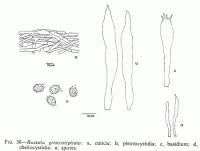 | 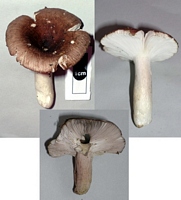
Owner: J.A. Cooper | 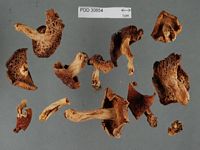
Caption: Dried type specimen
Owner: Herb PDD | 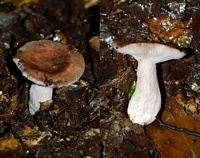
Owner: J.A. Cooper | 
Owner: J.A. Cooper | 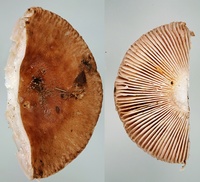
Owner: J.A. Cooper | 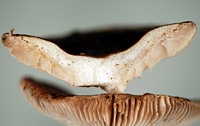
Owner: J.A. Cooper | 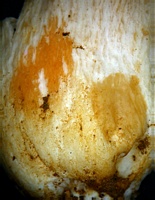
Caption: stem base. Left: FESO4, right: guaiac.
Owner: J.A. Cooper | 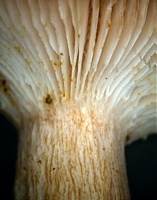
Owner: J.A. Cooper | 
Owner: J.A. Cooper | 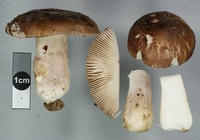
Owner: J.A. Cooper | 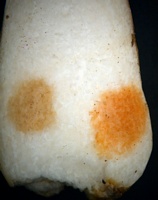
Caption: right: FeSO4, left: guaiac.
Owner: J.A. Cooper | 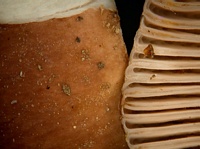
Owner: J.A. Cooper |
Article: McNabb, R.F.R. (1973). Russulaceae of New Zealand. 2. Russula Pers. ex S.F. Gray. New Zealand Journal of Botany 11(4): 673-730 (http://www.rsnz.org/publish/abstracts.php).
Description: pileus: 3.5-7 cm diam., hemispherical to convex
when young, centrally depressed at maturity, slightly viscid under wet conditions,
otherwise dry, glabrous to subglabrous, innately pruinose under lens, velar
remnants absent, dull red, dull greyish red, or occasionally dull brown with
dark red tints, paling towards margins, typically with a glaucous white bloom
in centre: margins entire, faintly pectinate for up to 1 cm from edge particularly
under dry conditions. Cuticle 150-200 µm thick, composed of interwoven, thin-walled,
equal or irregularly inflated, septate hyphae 2.5-4-(9) µm diam., erect or obliquely
ascending in young fructifications, becoming ± repent and slightly gelatinised
with age, terminal cells unspecialised: pilocystidia absent. lamellae: adnate to subdecurrent, moderately crowded,
moderately thick, simple or forked at any point between stipe and margin, to
7 mm deep, dull greyish white to greyish cream, often with faint greyish red
tints, lamellulae occasionally present. stipe: 4-5
cm long, equal or slightly tapering basally, 1.3-2 cm diam., dry, solid, glabrous,
innately reticulate under lens, pallid greyish white, often with faint greyish
red tints; flesh firm, white to sordid white, occasionally with yellowish stains
basally, unchanging on exposure to air. Cuticle similar to that of pileus, caulocystidia
absent. spores: spore print white; spores elliptical,
broadly elliptical, or obovate, obliquely apiculate, apiculus to 2 µm long,
7.5-9.5 X 6-7.5 µm. ornamentation of amyloid verrucae to 0.5 µm high, isolated,
in small confluent groups, or joined by extremely fine amyloid ridges and forming
an incomplete reticulum; plage absent. hymenium: basidia
hyaline, clavate, 38-60 X 7-10.5 µm, 4-spored, sterigmata to 7 µm long; pleurocystidia
scattered, rare to moderately numerous, sub-clavate to fusiform, hyaline, thin-walled.
Contents refractive in KOH, projecting to 25 µm beyond basidia, apices acuminate,
bluntly acuminate, strangulate, or occasionally mucronate, 60-97 X 6.5-11 µm;
cheilo-cystidia filamentous, to 3.5 µm diam. hymenophoral trama: heteromerous, intermixed. context of pileus: Sordid white to pallid brownish white,
tinted greyish red beneath cuticle, unchanging; structure heteromerous, clamp
connections absent. taste: lamellae and context mild. chemical characters: formalin on context—n.r.; phenol on context—
slowly deep vinaceous; FeS04 on context—rapidly salmon pink; guaiacol on stipe
base—rapidly salmon pink, darkening to deep orange-red; KOH on pileus—darkening;
on context—n.r.; NH4OH on pileus and context —n.r.
Habitat: Solitary or gregarious under Nothofagus.
|